When New Puppies Can Go Outside, According to a Vet
Your puppy’s outdoor adventures await — but vaccinations come first.
Your puppy’s outdoor adventures await — but vaccinations come first.
by Katie Koschalk, | August 26, 2024

Anna Kuzmenko / Shutterstock
As a new puppy parent, you’re probably eager to introduce your pup to the great outdoors, where they can socialize, explore different sights and sounds, and sniff everything within reach. Although taking your puppy outside is essential for their development, there are necessary steps to take before doing so.
Letting your puppy venture outside and mingle with other dogs without proper precautions can increase their risk of catching diseases. So, when can puppies make their big outdoor debut, and what do you need to do to prepare for this exciting milestone? We spoke to a veterinarian to get all the details.
According to Dr. Eliza O’Callaghan, managing veterinarian for Small Door Veterinary’s New York City practices, most puppies can start going outside when they’re around eight weeks old. However, as outlined below, there are some key considerations and steps to address before giving your puppy the green light.
Before a puppy starts going outside, they should have received the first core vaccination in their vaccine series, Dr. O’Callaghan says. The first shot is DA2PP, a 5-in-1 combination vaccine that immunizes dogs for five viruses, including canine distemper, adenovirus I and II, parvovirus, and parainfluenza. Puppies typically receive this vaccine at six weeks of age, but you should wait two weeks after this shot before taking your puppy outside. This gives the vaccine time to take effect.
It’s important to clarify that “taking a puppy outside” doesn’t mean you can immediately take them to busy dog parks or heavily trafficked public areas. Says Dr. O’Callaghan, “Instead, it involves introducing puppies to the outdoors in a controlled and cautious manner.” This might involve carrying your puppy outside so they can experience new sights and smells, or allowing them brief moments on the ground in your backyard — assuming you haven’t had any sick animals there in the past year.
The primary concern is that puppies can contract illnesses from other dogs or their environment. For example, parvovirus (aka “parvo”) spreads through feces and can survive in the environment for months, even through the winter. This means puppies don’t need direct contact with an infected dog to catch parvo. Simply coming into contact with a contaminated surface, such as soil or concrete, is enough. As you can imagine, there’s a much higher prevalence of viruses like parvo in public areas than in your backyard.
Since some infections, like parvo, can be deadly and often have no treatment beyond supportive care, it’s crucial to restrict outdoor time to safe areas until your puppy is fully vaccinated. (More on this below). Full vaccination status is generally achieved by 16 weeks old.
The health of your puppy should also be considered before taking them outside. If they have an existing illness or any health concerns, it’s best to discuss their condition and the appropriate steps with your vet.
Before taking your puppy outside, consider local disease outbreaks. Some areas may pose higher risks for certain infections or could be experiencing an outbreak. Talk to your vet about specific precautions based on your location to ensure your puppy’s safety.
What is the progression from only allowing your puppy brief moments outside in your backyard to letting them romp around with other dogs at a dog park? Let’s break it down.
Puppies typically begin their vaccine series when they’re six weeks old and receive boosters every three to four weeks, with the last one being given when they’re around 16 weeks old. Wait to take your puppy for a walk until two weeks after they’re fully vaccinated. This two-week waiting period is vital, as it allows the vaccines to fully take effect.
Just as with walks, you should wait two weeks after your puppy is fully vaccinated before taking them to a dog park because parks present a high risk of exposure to various illnesses. For most dogs, this means waiting until they’re 18 weeks old. At this time, puppies can go into public areas and interact with other dogs, as long as you’re supervising them.
While it’s very important to have proper precautions in place before taking your puppy to dog parks or busy public areas, there’s a bit of a catch-22. Puppies need to be socialized as much and as early as possible, ideally during their critical socialization period between three and 12 weeks of age. However, since puppies aren’t fully vaccinated until they’re about 18 to 22 weeks old, what can you do to facilitate their socialization safely?
Dr. O’Callaghan says puppies can begin interacting with other vaccinated dogs in controlled and safe environments when they’re as young as eight weeks old. Safe options to consider are puppy classes (which require that puppies have completed their first round of vaccines) or playdates in your backyard with healthy dogs that are fully vaccinated.
Before your puppy has completed their first round of shots, you can teach them to use indoor potty pads. This method helps keep them safe from potential outdoor pathogens while still establishing good potty habits. Here are some steps to follow.
Choose a designated potty area: Select a specific spot in your home where you want your puppy to use the potty pad. Consistency is key, so always place the pad in the same location.
Introduce the potty pad: Show your puppy the potty pad and encourage them to sniff and explore it. Praise and reward them for any interest shown in the pad.
Establish a routine: Puppies need to relieve themselves frequently. Take your puppy to the potty pad first thing in the morning, after meals, after playtime, and before bedtime. Regularly bringing them to the pad will help them associate it with potty time.
Watch for signs: Watch for signs that your puppy needs to go, such as sniffing, circling, or whining. When you notice these signs, quickly guide them to the potty pad.
Use positive reinforcement: When your puppy successfully uses the potty pad, immediately praise them and offer a treat. Positive reinforcement helps reinforce the behavior you want to see.
Clean up accidents promptly: Accidents will happen, especially in the beginning. Clean up any messes promptly and thoroughly to remove any lingering odor that might attract your puppy to the same spot.
Gradually transition to outdoors: Once your puppy has completed their first round of vaccinations, you can begin transitioning them to outdoor potty training in your backyard or a low-traffic area by your house. Start by moving the potty pad closer to the door, then outside, until they get used to the new routine.
Dr. O’Callaghan suggests cleaning your puppy’s paws after being outside to reduce the risk of bringing pathogens into your home.
Generally, puppies receive the rabies vaccine when they’re 12 weeks old, but it may be given to them as late as 16 weeks.
The parvovirus vaccine is part of the 5-in-1 DA2PP vaccine that’s given as a series of three shots. The first shot is usually given when they’re between six and eight weeks old, the second between 10 and 12 weeks old, and the third between 14 and 16 weeks old. Your dog will also need an annual DA2PP booster shot.
Newborn puppies (zero to two weeks old) should never go outside, because they’re unvaccinated and do not yet have a strong immune system. Puppies can begin going outside when they’re around eight weeks old after starting their vaccination series, but only in safe, clean areas free from unvaccinated dogs.
The Importance of Vaccinating Your Pet
Vaccination Guidelines for Dogs and Cats

Katie Koschalk is a freelance writer based in Northern California. Fusing her love and knowledge of animals with her journalism degree and years of professional writing, Katie is dedicated to improving the lives of pets and their caretakers by sharing helpful and accurate information. When she’s not at her desk, you can find her exploring trails with her Aussie, Hunter, cooking plant-based meals, and talking to her two cats, Jax and Sadie, in really ridiculous voices.
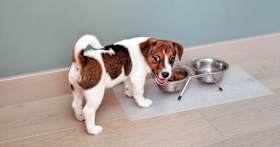
Adoption Advice

Adoption Advice

Shelters & Rescue
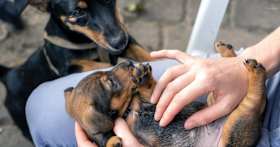
Adoption Advice
Worm infections are more common than you’d think, especially in puppies. But the good news? They’re very treatable.
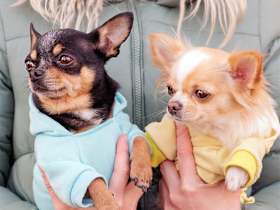
Breed Info
Want to know how to tell apart these Chihuahuas? Here’s how.
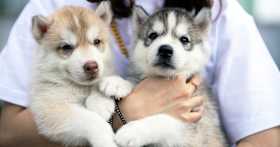
Adoption Advice
From bonding to socializing, raising puppies two puppies at once is a lot of work. Here is what to expect if you decide to get a dynamic duo.
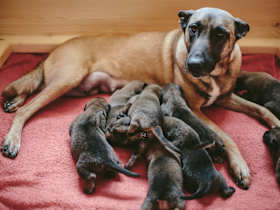
Adoption Advice
We’re sharing what you need to know about dog pregnancy and caring for a pregnant dog.
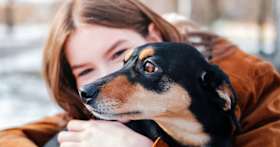

Behavior & Training
Worried about your dog’s sudden fear of the outdoors? It’s a common concern. Here’s how to help them overcome their anxiety.
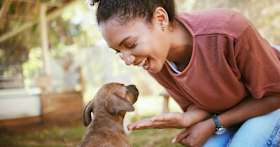
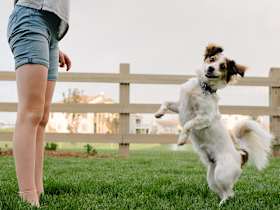
Adoption Advice
Learn the many benefits of adopting a shelter dog, and why giving a dog a second chance at a home is truly rewarding.

Adoption Advice
Learn what a rescue dog is and why these pups make the best buddies.